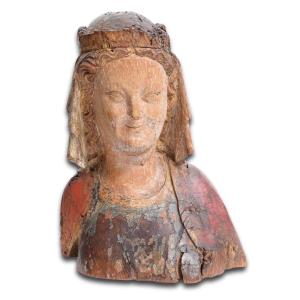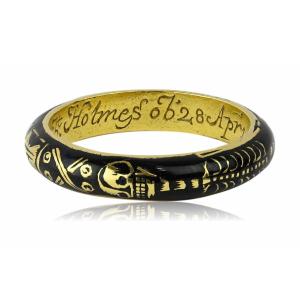Antwerp, mid 17th century.
Measures 52.5cm high, 48.6cm wide, 33.6cm deep.
The internal painted decoration includes a scene from Ovid’s Metamorphoses after an etching by Antonio Tempesta, circa 1606.
Exterior:
Rectangular in form with foliate gilt brass escutcheons. The upper section features a hinged lid above an ogee-moulded top, opening to reveal a painted and mirrored interior. Below this compartment, a frieze drawer sits above two panelled doors, with each corner decorated with foliate gilt brass mounts inset with oval, repoussé male masks in white metal. The base has a reverse ogee plinth with an additional moulded frieze drawer, and the cabinet rests on gilt brass bun feet adorned with acanthus leaf motifs.
Interior:
The inner surfaces of the doors are painted with verdant landscapes. On the left door, Thisbe stands over Pyramus, plunging a dagger into her heart; on the right, a hound drinks from a fountain, possibly inspired by Tempesta’s etchings of Ovid’s Metamorphoses. These main doors open to reveal a central pair of panelled doors flanked by columns, set beneath a balustraded frieze drawer. The interior panelled doors are flanked by six graduated drawers, the lower drawers with secret compartments, a verdantly painted landscape at the base. The interior side of the central doors also features scenic landscape paintings. When opened, these reveal a mirrored gallery with a checkered floor, centred by a painted panel of a turreted chateau, flanked by two painted female terms. The gallery ceiling is adorned with winged cherubim among clouds.
The cabinet is compete with two keys.
See the last image for a remarkably similar example in the collection of the Musée d’art et d’archéologie de Laon, France.
The casket is preserved in fine condition with it’s original paintings and metalware and with minimal conservation.
For the original etching of Thisbe and Pyramus from Ovid’s Metamorphoses after the Italian engraver Antonio Tempesta, see the British Museum, Bartsch / Le Peintre graveur (XVII.151.669).


















































 Le Magazine de PROANTIC
Le Magazine de PROANTIC TRÉSORS Magazine
TRÉSORS Magazine Rivista Artiquariato
Rivista Artiquariato